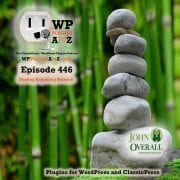Moving Your WordPress Blog
 Author: Danny Wirken
Author: Danny Wirken
Moving a blog can make it unreachable for 24 – 72 hours, unless the new domain name has fully propagated around the Internet. It is just the way it is and WordPress doesn't have anything to do with such limitation. Moving is best done when you have the time or have planned ahead.
Moving Towards a New Domain Name
The first thing to do is create a database back-up. The entire WordPress installation needs to be downloaded with no exceptions. This is not the time to tidy up your install or to upgrade/change anything. That would have to wait after the blog has been moved and is shown to be working. Your computer should now have these items: one or more database backups plus all your wpfiles, folders and images directories. The backups should be copied again to somewhere safe on your machine so that the next stage can be done on a copy.
Alterations are needed to be made. The details of your new mysql connection have to be changed by opening the file “wp-config.php” on your WordPress install. The file: SCR 1.0.002 Freeware Edition (13KB) should be downloaded to search and replace your website URL with your Xampp url. This is because your blog address inside the database has to be changed. Database files can be very large, thus opening them can be excruciatingly slow. It could even crash your machine. By replacing the old address with your new address, the URLs within your site will still work.
Moving hosts will mean changes in your passwords. You can double check your new passwords for your mysql connection as well as other passwords that you have in use. After which, it is now time to upload all your files to your new web space and restore your database. From the website cpanel, select the database you are using. You should still need to look inside the “wp – options” table to check that the values in “site – url” and “home” are correct. Clear your cache and cookies before checking your new site.
It is possible that you will get a blank page when looking at your blog right after moving. In this case, the themes should be checked. A faulty theme file causes a blank page. You can try changing themes or uploading a new theme then changing to it. Should this step not help, you should check whether all the WordPress files are present and are of the correct size. You can use your ftp client to download a new set of WordPress files, if needed.
There may be instances where you would need to move WordPress around within your server. WordPress is flexible enough to handle this situation. Moving WordPress from one server to another is also possible.
Moving Within
WordPress files can be moved from one location on your server to another. Start by creating the new location using any of these methods: create the new directory when you will be moving your WordPress core files to a new directory, or move the WordPress to your root directory by making sure all index, php, .htaccess and other files that might be copied over are backed-up and/or moved. This will then make the root directory ready for the new WordPress files. It is crucial that you set the URL locations before you move the file.
When done, test your site to confirm that it works right. Make sure that you let people know the new address when the change involves a new address to your blog. Consider adding some redirection instructions in your .htaccess file to serve as a guide to visitors towards the new location.
Handling Redirects after Moving a WordPress Blog
Concerns should not be limited to the moving of the actual WordPress program files but also on finding a way to redirect visitors that may be following outdated links to an old content. It is possible that redirects can mess up RSS feeds and search engine results thus an ideal redirect option that preserves both past and current search results is the key. After moving your WordPress blog, look into how 301 redirects can be properly handled.
A suggested way goes like this: open your .htaccess file in the directory that houses your newly moved WordPress file and edit in either your host's file manager interface or by downloading to your local machine. Insert a line at the top that reads: redirect301/blog/http://www.yoursite.com/. You have to make sure to insert the opening and trailing / at the end of the destination path. Save your .htaccess file. Reupload it if you're editing on your local machine rather than on the server. Load your old WordPress URL to make this work.
Moving Several Posts from One Blog to Another
When you decide to move over all your WordPress related posts from another blog, the task is basically to extract a few posts and their comments and to insert them into the database of the new blog. This can be accomplished by following these steps: click on the wp-posts table name in the left panel when you are in the proper database. It should be noticed that other tables might have a different prefix. Click browse on the top in the next panel. Select the checkbox at the beginning of the rows that you want to extract or export. Select “Export” at the bottom of the rows where it says “with selected”. Deselect structure on the next panel, leave selected Data, check Save As file, then Go. You will then get a prefix – posts.sqlfile.
Open the file in your chosen text editor such as Notepad. Change the wp-part everywhere to target_ -, depending on the prefix of the tables where you want to move the post using Search/Research. You are ready to go if you move the post to a new, empty database. However, if the target blog has posts in the database, there is some more work to do. You have to check in the database what the ID number of your last post is in the target blog. You should also go back to the .sqlfile and take a look at the first line below Dumping data for table…
Moving a WordPress Blog to Your Own WordPress Installation
WordPress is a platform you install on your own/hosted server and maintain the installation yourself. However, attempting to make the move should only be done if you're comfortable with ftp, basic work in the UNIX shell, basic SQL and a little bit of general hacking. Expertise is not really required but possessing the basic skills and the willingness to give it a go are.
The first thing to do is to install WordPress and get a hosting service. Choose one that does an automatic install of WordPress to do away with fiddling. Of course, you would need http://mysql.php, some form of ftp access and a shell account. The challenge lies on setting up your blog on a new place while finding the theme and the plugins you want. The themes on http://WordPress.com normally have links to places you can download them from.
About the Author:
Article Source: ArticlesBase.com – Moving Your WordPress Blog



